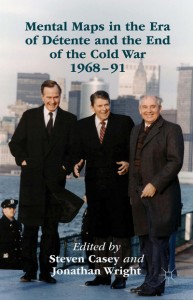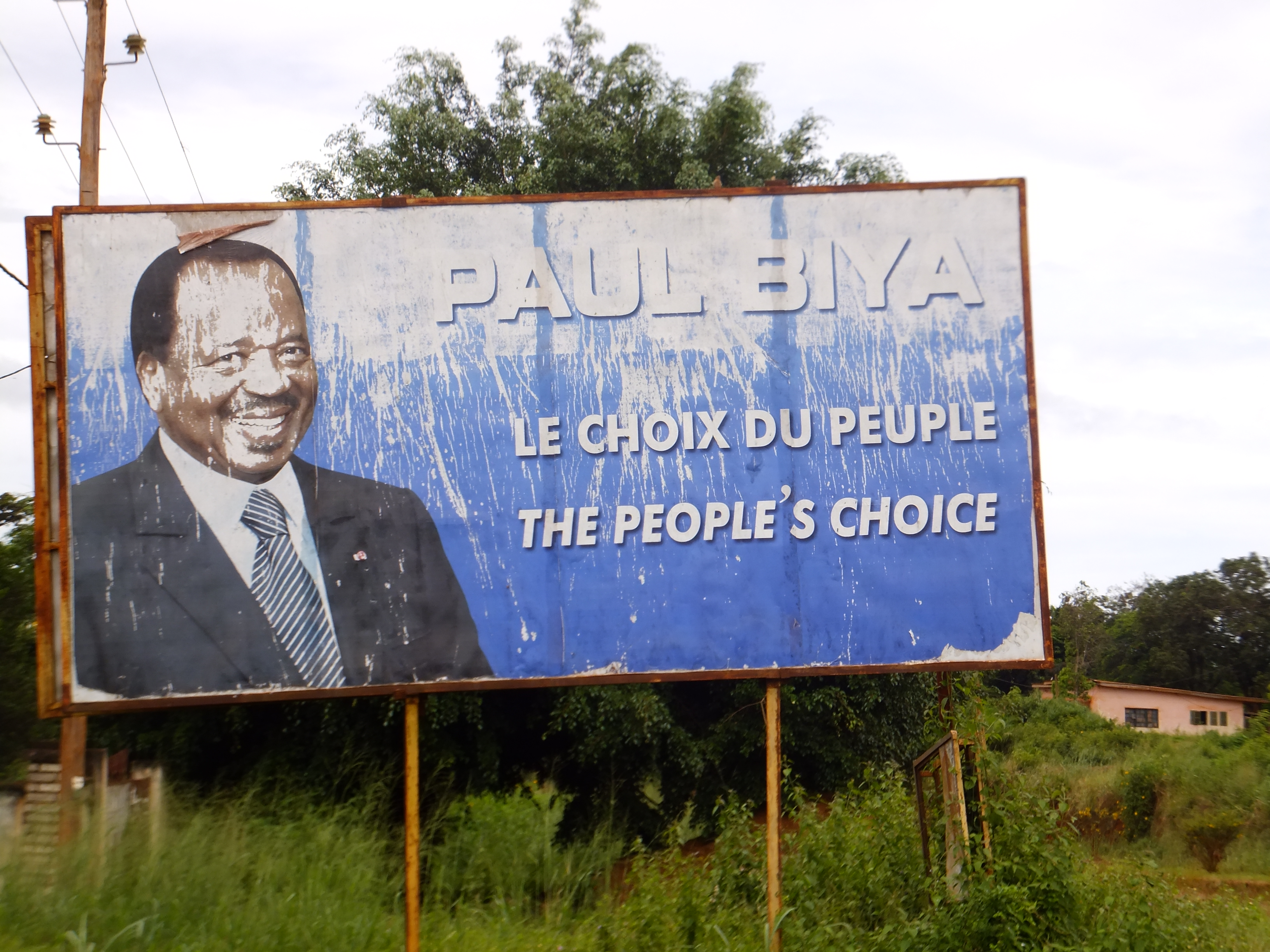 This review of Mental Maps in the Era of Détente and the End of the Cold War 1968-1991 is as much sweeping as it is detailed. Jonathan Wright highlights the main arguments each contributor has made to this edited volume dedicated to the thinking that prevailed during the closing decades of the Cold War. How did world leaders think? How did their thinking change and how did this impact the course of the Cold War? On behalf of his co-editor Steven Casey, as well as of each contributing author, Jonathan Wright makes the case that, “The great crises of the twentieth century sometimes allowed leaders even with very different ideologies to find something in common, a shared orientation in their mental maps.”
This review of Mental Maps in the Era of Détente and the End of the Cold War 1968-1991 is as much sweeping as it is detailed. Jonathan Wright highlights the main arguments each contributor has made to this edited volume dedicated to the thinking that prevailed during the closing decades of the Cold War. How did world leaders think? How did their thinking change and how did this impact the course of the Cold War? On behalf of his co-editor Steven Casey, as well as of each contributing author, Jonathan Wright makes the case that, “The great crises of the twentieth century sometimes allowed leaders even with very different ideologies to find something in common, a shared orientation in their mental maps.”
- Your volume with Steven Casey, Mental Maps in the Era of Détente and the End of the Cold War 1968-91 examines the geographic visions, underlying assumptions, and key priorities of fifteen major figures of the second half of the Cold War. What struck you, and your co-authors most about the origins of these Mental Maps? Were they most shaped by idiosyncratic personalities, individual histories, and particular social networks? Or were broader national cultures, or perhaps the geopolitical situation, more important?
Good questions! Broadly, as one might have expected, the origins of the mental maps are mostly associated with your first set of criteria, the way they were applied, with the second. Take the examples of Nixon and Kissinger. As Jussi Hanhimäki argues, both regarded themselves as ‘outsiders’. Each developed interesting ideas before 1969 about how the international system had become multipolar and how to construct peace and order in a new world, yet in office their central concern remained the Soviet Union – even the opening to China being seen as a tactic in that prior relationship. Each also continued to see the world in top-down terms, controlled by political leaders. Another example is King Hussein, who had, in Nigel Ashton’s words, a sense of dynastic mission part spiritual, part historical and part spatial. Jordan he said in private, should have ‘a larger future than a few thousand square miles of sand’. But his statesmanship was mainly concerned with survival in adverse conditions.
There are exceptions to this distinction between the way mental maps are formed and the way they are applied: as Archie Brown shows in his chapter on Gorbachev (on which more below), one of his distinguishing features was his ability to keep learning in office. His mental map never became fixed. Further, a tragic example was Salvador Allende who, in Victor Figueroa-Clark’s account, despite his long political experience, miscalculated the chances of democratic socialist reform in Chile. He was brought down both by the polarisation of domestic politics and by geopolitical isolation. A contrasting case is Nelson Mandela who, as Rita Barnard and Monica Popescu show, was attracted to revolutionary change in the 1960s following the examples of Cuba and Algeria and described Mao’s ‘Long March’ as a masterpiece. Yet, when he emerged from prison in 1990, he was able to adjust his mental map to become a beacon of unity and humanity in a post-Cold War world.
- How self-reflective or self-critical were the figures studied in Mental Maps about their own perspectives? Were they conscious that their decision-making and perception of events were heavily influenced by their quite particular perspectives and belief-systems? Or did they tend to take them for granted as just reflecting common-sense views of the world, which stood in contrast to the misguided ‘ideology’ of their rivals?
Again, Gorbachev stands out in his willingness to learn. On his frequent trips to Western Europe in the 1970s he was impressed by the freedom with which people talked, which led him to question his ‘a priori faith in the advantages of socialist over bourgeois democracy’. Another example is Willy Brandt who, having been an anti-Nazi exile in Norway and Sweden during the war, was able to see Germany – as others saw it – from the outside. The great crises of the twentieth century sometimes allowed leaders even with very different ideologies to find something in common, a shared orientation in their mental maps. Both Kohl and Gorbachev, for instance, had suffered as teenagers in the second world war and that provided a basis for building trust between them. At the other extreme is Nicolae Ceauşescu, whom Eliza Gheorghe describes as an autocrat capitalizing on his reputation for an independent foreign policy – ‘the de Gaulle of the East’. That enabled him to boost his domestic support, while in fact maintaining close links with the Soviet leadership. His mental map was shaped by exploiting the opportunities of a loosely bipolar world order, and showed no trace of self-criticism.
A pre-eminent example of dictatorship in the developing world is President Soeharto who, in David Jenkins’ account, after a career built on service with the Dutch, Japanese and Indonesian armies saw order as the essential value. He established his rule with extraordinary brutality, while subsequently overseeing a period of unprecedented economic growth. Julius Nyerere, by contrast, had a broader vision. As Emma Hunter shows, he held clear and consistent views. The core was liberation from colonialism at a time when the Cold War was still at its height on the African continent. But Nyerere, who had read history at Edinburgh University, was able to articulate his vision in a way which appealed beyond Cold War divisions. He actively supported liberation movements and welcomed aid from China. But at the same time he made impressive speeches at the United Nations and to the Non-Aligned Movement and helped to keep the Republic of South Africa out of the Commonwealth.
- Your own chapter in Mental Maps examines the West German Chancellors Willy Brandt and Helmut Kohl, two figures critical, in different ways, to the transformation and ultimate end of the Cold War. To what extent were Brandt’s and Kohl’s achievements indicative of their distinctive mental maps? Was Brandt’s Ostpolitik rooted in a very different mental map than other leading German politicians, or was he simply able to achieve what many of them would also have wanted? Similarly, was Kohl’s role in facilitating the end of the Cold War, and reunifying Germany, a product of his particular mental map, or would other German statesmen or women have acted similarly?
Let’s take Brandt first. Ostpolitik was certainly not his alone. It had strong support in the SPD and the liberal FDP. It was a defining issue in the 1969 elections, as a result of which they were able to form a government, though with a very narrow majority, and the issue in the subsequent 1972 elections which they won comfortably. Ostpolitik meant more than foreign policy. In Peter Pulzer’s words, ‘A generation preoccupied with repairing the ravages of war yielded to one more conscious of missed opportunities and superannuated taboos’. Willy Brandt caught that mood perfectly, in his youth in the Weimar Republic a left-wing socialist and an anti-Nazi exile, but also as Mayor of West Berlin a champion of that city’s independence, when it was threatened with Soviet takeover and the wall was built. If anyone could articulate the desire for peace, détente and negotiation to replace the stale rhetoric of the Adenauer era, it was Brandt. He did so brilliantly in words that were carefully chosen, suggestive and open-ended. Adenauer’s ‘reunification through strength’ was replaced by ‘change through drawing closer’, a phrase coined by his close adviser, Egon Bahr.
Even more important arguably was Brandt’s ability to communicate his commitment to peaceful change to Soviet and East European leaders, and again his authority as an anti-Nazi exile was pivotal. Soviet propaganda that the Federal Republic was a neo-Nazi, revanchist state simply did not make sense when set beside the photograph of Brandt kneeling in December 1970 at the memorial to the victims of the Warsaw ghetto uprising of 1942. The respect and even friendship which Brandt was able to establish with Brezhnev was crucial to the success of Ostpolitik. It was also important for the process of superpower détente. As Vladislav Zubok shows, Brezhnev, who epitomised a highly traditional view of security, based on military power and territorial defence, had also become convinced of the need to limit the cost of the arms race. In Brandt he found a trusted partner in détente and that gave him the confidence to continue the process with Nixon and Kissinger. In brief, Ostpolitik had substantial support but Brandt’s mental map had the unusual extra dimension – of exile – which made him uniquely qualified to put it into practice.
The story of Kohl and unification is on the surface simpler. Coming from a Catholic family in the Rhineland Palatinate, he rose swiftly through the ranks of the CDU establishing his reputation as an astute party manager. He finally became Chancellor in 1982 as result of a coalition switch from the SPD by the FDP. There was nothing to suggest that his attitude to unification was different from that of most Germans. By the 1980s there was still a large, though gradually declining, majority in favour, but only a small minority thought it more than a long term prospect. At the outset Kohl was more concerned with (West) European integration and NATO, particularly the deployment of medium range missiles despite mass protests. When it became clear in 1989 that the GDR was in crisis as a result of Gorbachev’s reforms in the Soviet Union and its own failure to reform, Kohl was suddenly faced with multiple challenges which no-one had foreseen. When the wall fell, the West German government still had no plan for unification. Where Brandt had devised a strategy to maintain a sense of German nationhood in the long term, Kohl had to find a way of keeping up with events which threatened to run out of control. He wrote later that ‘On many days it was almost like a dream, so much happened so rapidly that many could hardly take it in any more – I was no exception’. Yet, he showed a capacity to act decisively which was in contrast to his previous career as a generally cautious and consensual politician.
What made the difference? One reason he gave was ‘I knew what I wanted’. On his mental map unification had always been a desirable, if distant, goal, now it was within reach and he did not hesitate to redraw the map. That reaction was also true of other leading politicians in the CDU and FDP and of Brandt and much of the SPD. But there were other reactions – the SPD’s candidate for the Chancellorship in 1990, Oskar Lafontaine, was critical of what he saw as Kohl’s outmoded nationalism and warned of the economic consequences of unification. Kohl remained undaunted, acting at key moments to accelerate the process despite the risks. He assured himself of President Bush’s support by his commitment to united Germany remaining within NATO, remained conciliatory to Gorbachev and responded to his ever more urgent requests for credits, calmed Mitterrand’s fears by remaining firm in his support for European integration including monetary union, stood up to Thatcher who was quickly isolated, and above all demonstrated that no-one had a viable alternative to unification. Kohl was at his best with simple truths. As far as he was concerned, unification was a goal which had been espoused by German governments since 1949 and endorsed by its Western allies. It was overwhelmingly what the German people wanted. Nobody could stop it. All the problems it raised were of secondary importance and could be resolved later. Others might well have acted similarly but he provided the energy and clarity of someone convinced that he had been presented with ‘a unique historical opportunity’.
- In explaining the end of the Cold War, scholars have placed particular emphasis on Gorbachev’s new thinking, and his mental map, in accounting for the Cold War’s end. Does the research behind Mental Maps reinforce this view, or show ways in which other figures were more important than is often appreciated?
Gorbachev’s role was clearly fundamental and that is reflected in the mental maps of all the other key players. Western leaders feared that Gorbachev might be overthrown and the process of reform reversed. The main contribution they made was a gradual recognition of the significance of what Gorbachev was doing, and helping to give him the space to do it. As Luis da Vinha argues, Ronald Reagan moved from the doctrinaire anti-Communism of his mid-Western background to recognizing Gorbachev as a partner in the process of nuclear disarmament in which they both believed. Reagan also had the invaluable ability, unlike Carter, to carry American opinion with him. Gorbachev’s vulnerability was a two-edged sword. Kohl saw it as an argument for accelerating the pace of German unification while the opportunity was there. Others, like Thatcher, and Germany’s Foreign Minister Genscher, feared that putting Gorbachev under too much pressure might provoke a reaction – as indeed happened in the coup of 1991. A different perspective was that of Deng Xiaoping. As Yafeng Xia shows, this supple pragmatist was, after Mao’s death, above all concerned with China’s economic development, becoming part of the international economy and ensuring rapid growth. By the mid-1980s he aimed to mend fences with the Soviet Union and shelve disputes with China’s neighbours. In private, he was critical of Gorbachev whom he saw as having undermined, by political reform, his ‘power to fix the economic problems’. But his advice to his successors in the 1990s was not to claim a leadership role after the collapse of the Soviet Union, but to continue to work for a peaceful and stable environment in which China could develop its strength and improve the living conditions of its people. This too was an important, if often overlooked, contribution to the end of the Cold War.
5. Mental Maps is mainly focused on the leaders of states. To what extent were the mental maps of others important in the development of the later Cold War? Did the leaders of non-state organisations (I think of figures like Lech Wałęsa, co-founder of the Solidarity movement in Poland), or the mental maps of broader publics play as important a role, or were they less critical to the course of international politics? Is this an important future area of further research?
We have focused on political leaders. The idea of exploring their ‘mental maps’ as a way into understanding the international history of a particular era (earlier volumes explored the era of the two world wars and the era of the early Cold War) is to uncover not only what made these leaders unusual but also their sense of the constraints, both domestic and international, with which they were faced, and also the opportunities that might arise. The mental maps of individuals are both shaped by structural forces and help to shape those structures. So, I would not make a sharp distinction between individual leaders and broader publics. That said, of course, broader social movements are significant, not least the various dissident movements in Central Europe for the end of the Cold War. And one could argue that some of these movements have more than a political dimension, for instance the role of Catholicism and the influence of a Polish Pope, John Paul II, in Poland. In our volume, we have a chapter on Václav Havel. Havel was, after all, an intellectual and a playwright who became a political leader. As Kieran Williams describes, his writing about identity, meaning and truth from his central European vantage point in Prague was directed not only towards the Communist oppression under which he suffered directly, but also included a wider critique of all forms of industrial society. Havel’s ‘anti-political politics’ is a reminder of the importance of intellectual currents which may have great political significance.
The concept of mental maps does have, I believe, potential for further research at both the individual and group level. A recent workshop in Stockholm brought together work as varied as West European attitudes to Eastern Europe from the eighteenth century to 1989, Israeli students’ knowledge of the Palestinian areas of the country, the conflicting mental maps of 20th century Lebanon, mental maps of Europe based on quantitative evidence from surveys of European and extra-European students, and comparative work on mental maps in the Baltic and Mediterranean regions. As this summary shows, the possible applications range widely. One definitional question is whether a mental map requires a visual representation. That is relatively easy with survey evidence, harder in the case of individuals. Maps, like numbers, are always reductive as representations of the truth. So there is a case for allowing ‘mental maps’ to continue to be interpreted freely as portraits in prose.






No Comment